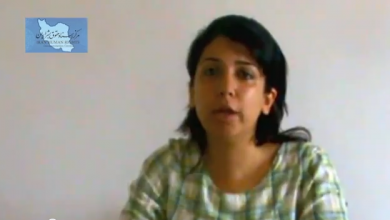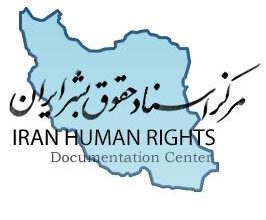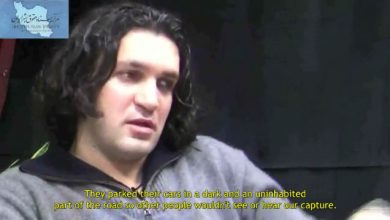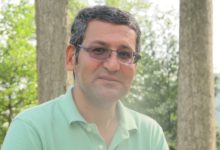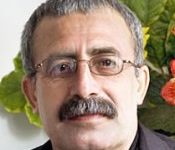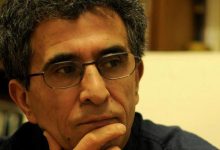Witness Statement: Kourosh Sehati
Kourosh Sehati is a human rights activist and former member of several student groups in Iran. He was expelled from university because of his political activities and helped organize the July 1999 student protests. In this witness statement, Sehati describes his numerous arrests between 2000 and 2004, and his experiences in illegal detention facilities.
Full Name: Kourosh Sehati
Date of Birth: 1978
Place of Birth: Tehran, Iran
Occupation: Former Agricultural Engineering Student at Varamin University and Member of the United Students Front
Interviewing Organization: Iran Human Rights Documentation Center (IHRDC)
Date of Interview: October 26, 2008
Interviewer: Neda Shahidyazdani
Witnesses: None
This statement was prepared pursuant to an in-person interview with Mr. Kourosh Sehati. The statement consists of 40 paragraphs and 10 pages. The interview was conducted on October 26, 2008. The statement was approved by Mr. Sehati on December 28, 2008.
Witness Statement
1. My name is Kourosh Sehati. I was born in 1978 in the city of Tehran. I have been living in the United States as a political refugee for the past three years. Before that I was an agricultural engineering student at Varamin University. I was expelled from the Varamin University due to my political activities in connection with the United Students Front (which I helped found), and especially my role in the student uprisings on July 9, 1999.
2. I was arrested and detained several times by the Islamic Republic. I was detained for short periods of time following several run-ins [with the police], and several times due to my political activities.
3. I was first arrested on December 7, 1998 by the intelligence officers of the Law Enforcement Forces because I participated in a gathering commemorating Students Day at Tehran University. I was detained for one day.
4. The second time I was arrested on June 19, 1999 by the Amaken office of the Law Enforcement Forces next to the Hosseiniyihyyih Ershad. I was detained for one day. My friends and I had gone to the Hosseiniyihyyih Ershad to commemorate the anniversary of Dr. Shariati.1 A scuffle broke out between the students and Ansar-i Hizbullah. The Law Enforcement Forces arrived and Ansar-i Hizbullah delivered us to them. The Amaken forces then took us to a secret detention facility next to the main Law Enforcement Forces building, which was located on Motaharri Street. They blindfolded us and kept us there for several hours. I didn’t have an ID card on me and they didn’t know who I was. I used a fake name when I introduced myself. A little while later I was released along with 4 others.
5. Amaken does not have the right to arrest and detain political activists, but during those years this agency was engaged in illegal activities. My guess is that we were some of the first individuals to have been detained at this secret prison. After us, they took several writers (who were members of the writer’s guild), such as Mohammad Ali Safari, to this prison and interrogated them.
6. The events of July 9, 1999 occurred 20 days after [my latest arrest]. The United Students Front played a very important role in the planning and staging of the July 9th student demonstrations. Because I was a member of the United Student Front’s central committee I was heavily involved and active in these demonstrations. I gave interviews to radio stations and media outlets regarding the students’ demands and their circumstances. I was also responsible for taking food to the students at the university dormitory and collecting money on their behalf.
1 Dr. Ali Shariati was an Iranian sociologist and intellectual. He is regarded as one of the most influential Iranian thinkers of the 20th century, and one of the most important ideologues of the Iranian Revolution.
7. It must be noted that the United Students Front had no intention of causing trouble with the Law Enforcement Forces and Ansar-i Hizbullah. Ours was the politics of non-violence. We were not involved in the conflict that arose between the students and Ansar-i Hizbullah and the Law Enforcement Forces. Another violent group student group was responsible [for the trouble]. This group had had several run-ins with both the Law Enforcement Forces and the Ansar-i Hizbullah before the events of July 9, 1999. [This group] had aggressively resisted the Law Enforcement Forces and the Ansar-i Hizbullah, and these [government forces] feared them. But they were also looking for an opportunity to get revenge against them. The students had grown bold as a result of their successes, and I think this was one of the main factors leading to the violence used by the Law Enforcement Forces against [us]. The Law Enforcement Forces wanted to teach these students a lesson.
8. The Law Enforcement Forces and the Ministry of Intelligence viewed me as one of the major instigators of the July 9, 1999 incident. One week after this incident, Ministry of Intelligent agents stormed our home. I had been tipped off a few hours prior to the Ministry of Intelligence’s attack. Several members of the Iran’s People Party, which had good relations with the United Students Front, informed me that they wanted to arrest me. (Indeed, several of my friends who were members of the United Students Front had already been arrested.) This is how I knew they were looking for me. My family was at home, but I wasn’t there.
9. The Ministry of Intelligence had secured my arrest warrant from Branch 6 of the Revolutionary Court. Even though Ministry of Intelligence agents knew I was not armed, they entered our home without permission and with weapons drawn. Our house had four levels. They simultaneously occupied all floors and proceeded to rummage through everything violently. My mom later told me that they had kicked the door wide open and entered the house by force. My mother wasn’t wearing a hijab. She began to argue with them, condemning them for pretending to be good Muslims while entering homes without permission and without allowing an opportunity for women to cover up. My mother was finally able to cover up and managed to hide some of my documents and writings. They couldn’t find me at home, but they abducted my brother (who is a year old than I am). They released him after midnight.
10. A few of my friends were convicted of heavy crimes. Akbar Mohammadi was sentenced to death. I spent some time in hiding. The July 9, 1999 incident came and went, the dust settled, things calmed down and I came out of hiding. Despite the fact that I had been charged with serious crimes, they failed to come after me.
My First Arrest
11. I did not curtail my activities when I was in hiding. I continued my previous political activities and after a while launched Gozaresh-e Rooz newspaper with the help of some of my friends. We published about 40 issues of this publication. On April 10, 2000, after Khamenei’s speech and assault on the press, Gozaresh-e Rooz and several other dailies were shut down by the Press Court and we decided to convene several sessions criticizing [the government’s actions]. It was around the middle of June 2000 and I was at the newspaper office. Four armed and intimidating plainclothes agents entered the office and introduced themselves as agents of the Ministry of Intelligence. They didn’t produce an arrest warrant, but they informed me that I was under arrest and that I should go with them. They said they had a few simple questions to ask, but instead they took me straight to Evin Prison. I spent a month in solitary confinement and was denied visitation rights. The night after my arrest, Seyyed Majidpour-Sayyef (Judge Haddad’s deputy from Branch 26 of the Revolutionary Court) came to Evin Prison and signed my temporary arrest warrant.
12. After 3 months of detention in Section 209 of Evin Prison (the last 2 months of which were spent in the public ward) they transferred me to the quarantine ward, which was extremely filthy. Prisoners are kept in the quarantine ward after they enter Evin Prison and before they are transferred to the public wards. The quarantine ward only has 2 restrooms, even though it housed more than 1,000 prisoners. Everyone slept in the hallways and small cells which were filled beyond capacity with prisoners. We were not allowed to wear shoes; we could only walk around in slippers. I broke my leg during the one hour daily exercise break we were given in the quarantine ward. They did not provide any medical treatment. I told them that I wanted to pay for my own treatment, but they did not allow me to do this. Instead they gave me some painkillers [and said] my legs would eventually heal by themselves. Even to this day, I suffer from [leg pain], especially during the winters. I was not allowed any visitors in the quarantine ward. I contracted scabies and became ill. After that they transferred me to rehabilitation area 3 of Evin’s general ward, which at that time was set aside for political and national security prisoners. I was [finally] allowed visitors [while detained there].
13. According to the courts, I was charged with attempts against the country’s national security and propaganda against the regime by way of membership in illegal groups (along with participating in disruptive student demonstrations). The interrogations did not follow a set schedule, but were not accompanied by beatings and violence. Khatami’s government was in power and the Ministry of Intelligence opposed the conservatives. I was usually questioned by one, two or more interrogators and was always blindfolded. Some of the questions had nothing to do with my charges, such as those concerning my personal relationships and personal opinions. During the first night of my arrest, the judge’s clerk came to explain my charges. When I slightly removed my blindfold so that I could sign the charge sheet, he slapped me hard. When I asked him why he hit me, he said, “You are right; you would have eventually seen my face in court anyway. It doesn’t matter – it was just a slap.”
14.I retained a lawyer before my trial. The judge refused to allow my lawyer full access to my file, even though the file merely put forth my charges.
15. Four months later I was released from Evin Prison on bail. Despite the illegal treatment I received in prison, I decided against filing charges against my interrogators because I had no confidence that the Islamic Republic would prosecute my case in a just manner. I did, however, describe the manner in which they treated me in newsletters circulated by the United Students Front and Farsi language media outlets outside the country.
My Second Arrest
16. My days of freedom did not last long. I was arrested again on March 4, 2001 by the Intelligence Protection Organization and sent to prison. I spent about 7 or 8 months in solitary confinement inside a secret detention facility.
17. During Khatami’s presidency an intelligence rift occurred between the Ministry of Intelligence and intelligence agencies under the supervision of Khamenei such as the Intelligence Protection Organization of the Revolutionary Guards, the Intelligence Protection Organization of the Office of the Supreme Leader, and the Judiciary. Khamenei used intelligence agencies that were directly under his control to silence the civil society and student movement. According to the law, the Ministry of Intelligence (under the supervision of the Judiciary) is tasked with the responsibility of investigating national security charges. But because the rift between the conservatives and the reformists had deepened inside Iran’s intelligence agencies, the Intelligence Protection Organization of the Revolutionary Guards took on the responsibility of interrogating us and detained us in a secret facility under its control.
18. The reason for our arrest was a celebration to commemorate Dr. Mossadiq at Tehran University. I was headed towards Laleh Park from Enqelab Square with two of my friends. One side of the street was empty and directly in front of it was a blocked off street. All of a sudden I realized that 10 to 12 strong plainclothes agents had attacked us from behind, bound are hands and feet and threw us inside a car. They kidnapped us in plain sight. From there they took us to a detention facility that was close to the Towhid (a former detention facility run by the joint committee against sabotage, which was owned by the Intelligence Protection of the Law Enforcement Forces and was located in Tupkhaneh Square). The cells in the detention facility were dark and dingy. Pursuant to the law, they were not allowed to hold us there for more than 24 hours, but they detained us for 4 days. They briefly informed me that I had been charged with starting an illegal demonstration.
19. After four days, they took us to Branch 26 of the Revolutionary Court. We waited for a while until they came for us. I asked them to contact my family to at least let them know that I had been arrested, but they refused to comply. Judge Haddad said, “Since your case file is security-related, we will announce that you are alive and healthy but will not tell anyone where you are. We will take you where no one can find you.”
20. During my transfer from court to the detention facility I got in an argument with some of the Revolutionary Guards agents. They beat me ruthlessly. They grabbed me by the neck and threw me in the car. Then they punched and kicked me. They blindfolded us again and took us to a detention facility, which I later determined was at Eshratabad, a military base run by the Revolutionary Guards. I had been severely bruised and had sustained injuries to my eyes and ribs as a result of my violent encounter with the Revolutionary Guards intelligence agents. They failed to let me see a doctor for several days. I complained a lot. They finally took me to an ophthalmologist. They left me with the doctor. I took off my blindfold and noticed the name Najmiyih Hospital above the doctor’s prescription letterhead. Najmiyih Hospital was founded by Mrs. Najam-ul Saltaneh, Dr. Mossadiq’s mother, and is currently administered by the Revolutionary Guards. I found it ironic that I’d been taken there by the Revolutionary Guards because I had participated in a gathering commemorating Dr. Mossadiq.2
21. They threw me in solitary confinement yet again. The solitary cell was extremely small – it was about 1.5m by 2m. Confinement in that cell was a form of torture. No only do they withhold information from the detainee but they feed him lies. For instance, they tell you that they’ve arrested someone and that that person has accused you of certain acts. They let me meet [my family] only once during the duration of my stay in solitary confinement. During that meeting I decided to show my family my blood-stained clothes in order to let them know what had happened to me there. The guard noticed my clothes and informed my interrogator. One of them came and said, “You want to play the hero and tell them that we beat you?” They confiscated my clothes and sent them to the dry cleaners. Of course, they charged me for the service. They told my family to visit me the day after.
The Interrogations
22. At Eshratabad the interrogations started from the first evening and were extremely violent. The interrogations were long and exhausting, and usually occurred during the evenings. I was blindfolded.
23. The interrogators wanted to break us. They threatened and cursed us. They cursed both me and my friends. They accused the families of politically active [reformers] of unmentionable crimes. They woke me up in the middle of the night and subjected me to questioning sessions conducted by multiple interrogators. They sat me in a school desk facing the wall. If they wanted me to write down the answer to a question, they allowed me to slightly adjust my blindfold. The interrogators always sat behind me. Sometimes several people sat behind me – other times there was only one individual. Interrogations lasted for 6 to 7 hours. When one interrogator got tired, another one would replace him and continue with the same questions.
2 Muhammad Mossadiq was the Prime Minister of Iran from 1951 to 1953. He initiated the nationalization of Iran’s oil industry and was overthrown as a result of a coup engineered by U.S. and British intelligence forces in 1953.
24. The questions were divided into several parts. The first part involved my past activities. The second one concerned my opinions and beliefs. For example, they’d ask me which political group I was affiliated with and why. These questions had nothing to do with my charges. The third part covered my [sexual] relations with female members of these groups. My interrogators asked me which women I had relations with and why. They concentrated on sexual relations and unfounded charges in an effort to break my psychologically.
25. The objective of the interrogators was to break and shame the detainees. They were aware of all of our activities (because we operated in the open). We were permitted to gather and our activities were all public. We had a publication, we wrote, we had an office, and we went about our business. Moreover, the Ministry of Intelligence had infiltrated our group and had informants. They were monitoring all our activities and were slowly constructing a case against.
26. The interrogations, threats and insults lasted for more than a month. But my interrogators failed to inform me that my arrest warrant (and detention) had been extended for another month. My guess is that it hadn’t. According to the law they are required to let detainees know the reasons for prolonging their detention. This type of illegal treatment continued throughout my detention.
27. Judge Haddad, the head of Branch 26 of the Revolutionary Court, came to see me at Prison 59 in Eshratabad. But he’d come to threaten me instead of talking about my charges. He said, “You have to tape a TV interview asking for forgiveness for your past activities.” The interrogators and the judge had one goal in mind. They wanted to break and ruin us so that we would cease our political activities. They wanted to secure confession letters from us and publish (or broadcast) [our confessions] in case we decided to continue our political activities.
28. They were not able to secure a confession letter out of me. During my interrogations I tried very hard not to provide my interrogators with extra [or unrelated] information, and attempted to answer questions in a manner that would relieve pressure on me. To the extent that our activities were public in nature, I tried only to name individuals who were openly members of our organization or had published articles for us.
29. They didn’t beat me in Prison 59, except for the time they hit me while I was in court. They slapped me around a couple of times, but they didn’t really torture me in the classic sense.
30. In Prison 59 they took us to the restroom 4 times a day. After a few days, they took us out to a small yard for about 10 minutes every day so we could get a breath of fresh air. Sometimes we snuck in a conversation with some of the other detainees who were out in the yard with us. The guards didn’t let us talk to each other. We gathered a lot of information [about our condition] when we went for our walks. For example, we found out that we weren’t the only detainees in Eshratabad. Sixty to seventy of the Religious-Nationalists and Freedom Movement of Iran members, such as Mohandes Sahaji, Dr. Payman, Basteh Negar, Raja’i, Ali Afshari and others were also detained there.
31. I went on a hunger strike in Eshratabad to protest the pressure they put on me to secure a television confession.
32. Before the anniversary of the July 9th [events], the Intelligence Protection Organization of the Revolutionary Guards took me, Sa’id Kashiloo, Hamid Reza Mobin and Heshmatollah Tabarzadi to another detention facility. They took us to a detention facility administered by the Intelligence Protection Organization of the Ministry of Defense, which we later learned was Prison Jay. All the guards at this prison wore military uniforms and boots. Our cells often shook as a result of the many planes flying overhead. Every time we used the restrooms, the guards thoroughly searched our cells. They allowed us access to fresh air, but they searched us extensively every time they did. We were subject to a lot of pressure there. One of my friends, Hamid Reza Mobin, who was younger than the rest of us and was only 19 at the time, suffered a heart attack while in detention and was released because of his condition.
33. After Prison Jay they transferred us back to Prison 50 in Eshratabad, and then to Evin Prison. All in all we spent more than 7 months in solitary confinement. Five months were spent in Eshratabad, one month in Prison Jay and the last month in Section 240 of Evin Prison. After seven months I was released from prison on bail.
My Third Arrest
34. Like before, my freedom didn’t last long. In December 2002 we conducted a session with the Nationalist Party of Iran (on the threshold of the anniversary of the [murders of the] Forouhars).3 I left the meeting and sat in my car. Someone knocked on the window. I thought he was a beggar. I asked him, “What do you want?” The man said, “Open the door; I want to sit in the back.” I understood what the matter was. I opened the door. He got in and sat in the back seat. He picked up one of the announcements that we’d circulated regarding the commemoration of the Forouhars’ [assassination] and read it. In it we implicated the Ministry of Intelligence in the Forouhars’ murders. Then he said, “Right, so does this mean that we killed them?” I said, “As far as I know the Ministry of Intelligence has accepted its involvement in these murders – what do you want from me? He commanded me to “Sit right here.” A short while later, his boss arrived. He did not allow me to turn around and look at him. He knew my name and called me by it. Again, he didn’t let me turn around and look at him. He asked me “if I wanted to leave my car at this place or take it with me.” I said, “[I prefer] to leave it here.” Then he blindfolded me and took me to another car which was an old Mercedes Benz. From there, they took me to the investigations office of the MOI, which was near the intersection of Vali Asr next to Juraban store in Baradaran-i Mozaffar Street. By law they did not have the right to detain anyone there because it’s not an official detention center. But the MOI unlawfully used this location as a temporary detention facility to intimidate the accused. I was threatened there and warned not to participate in the anniversary of the deaths of Daryush and Parvaneh Forouhar. They released me a few hours later.
3 Dariush Forouhar was a founding member of the Nationalist Party of Iran and served in Mehdi Bazargan’s provisional government after the Shah was overthrown. He and his wife later became critics of the Islamic Republic. They were assassinated by “rogue elements” within the Ministry of Intelligence in 1998, along with a series of other intellectuals. These assassinations are referred to as the “Chain Murders.”
35. But three or four days I participated in the fourth anniversary ceremony of the Forouhars. A huge scuffle broke out between the ceremony participants and Ansar-i Hizbullah forces. I was arrested again by the Ministry of Intelligence, along with my mother and two of my other friends. They released us around 2 or 3 a.m. in Karim Khan Zand Street.
36. In April 2003, I was sentenced to 6 years for attempts against national security (as part of a series of convictions in Branch 26 of the Revolutionary Court). They transferred me to Qasr Prison in order to apply more pressure on me. Prior to the revolution Qasr Prison was used to hold political prisoners. I was among the first political prisoners to be taken to this prison post-revolution. Branch 36 of the appellate court in Tehran affirmed the six year sentence. After that, they transferred me to the murderers and drug addicts ward in Qasr Prison. Seventy or eighty percent of the prisoners there had gone crazy because of the severe torture they had been subjected to. (For example, [some] of them would [walk around] the rest of us naked and urinate.) Scuffles broke out all the time between prisoners and drugs were easily available. The security situation there was terrible.
37. My sentence was ultimately reversed in Branch 5 of the Supreme Court and I was released from Qasr Prison in February 2004.
38. The first time I had a lawyer in court, but I didn’t hire one after that. After my first trial I came to the conclusion that having or not having a lawyer didn’t really affect the court’s ruling because lawyers don’t have access to the case files. Once Mohammad Ali Safari, a 70 year old lawyer, volunteered to defend me. He was arrested and imprisoned. I decided not to get a lawyer when I realized that retaining or not retaining a lawyer had no real bearing on the court’s decision.
39. A while later and after my release, the United Students Front staged a demonstration in June 2004 in front of the United Nations office in Tehran in support of political prisoners in Iran. They arrested several of my friends after the demonstration. I was the only member of the central committee of the United Students Front who remained free. I conducted several radio interviews. The Ministry of Information came after me but I realized this and fled. I went home. Then I hid elsewhere. After this the Ministry of Intelligence requested that I be given a ten to fifteen year sentence in prison.
40. Before that I was summoned by telephone several time by the Revolutionary Court. But I didn’t go. I told them that the Revolutionary Courts are illegal, and that I didn’t know who they were and why they wanted me to go. Their actions were illegal. They have no right to call you and expect you to go there at their beck and call. [I did this] even though I recognized the voice of the person calling to be that of Judge Haddad’s deputy, Seyyed Majidpour-Sayyef. Seyyed Majid used to threaten me via telephone, and say things like “I will order them to arrest you.” I would respond: “You have to send me a written summons.” Finally (and as I mentioned before), after years arrests, convictions, threats and hiding, I was forced to illegally flee Iran by crossing the border into Turkey in June of 2004. The Office of the United Nations High Commissioner for Refugees in Van, Turkey affirmed my application for asylum. I spent one year in Turkey and have been living in the United States for the past three years.

